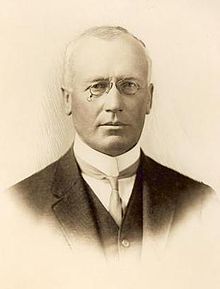William Irvine (Australian politician)
Sir William Irvine | |
|---|---|
 | |
| 21st Premier of Victoria | |
| In office 10 June 1902 – 16 February 1904 | |
| Preceded by | Alexander Peacock |
| Succeeded by | Thomas Bent |
| Constituency | Lowan |
| 9th Attorney-General of Australia | |
| In office 24 June 1913 – 17 September 1914 | |
| Preceded by | Billy Hughes |
| Succeeded by | Billy Hughes |
| Constituency | Flinders |
| Personal details | |
| Born | 6 July 1858 Newry, County Down, Ireland |
| Died | 20 August 1943 (aged 85) Toorak, Melbourne, Australia |
| Political party | Commonwealth Liberal Party |
| Spouse | Agnes Somerville |
Sir William Hill Irvine, GCMG (6 July 1858 – 20 August 1943), Irish born-Australian politician and judge, was the 21st Premier of Victoria. Irvine was born in Newry in County Down, Ireland, into a Scottish-Presbyterian family; he was the nephew of Irish revolutionary John Mitchel. He was educated at the Royal School, Armagh and Trinity College, Dublin, graduating in law in 1879 before migrating to Melbourne, where he taught in Presbyterian schools and read law at Melbourne University, gaining a master's degree in arts and law. He soon became a leading Melbourne barrister.[1]
Career
In 1894, Irvine was elected to the Victorian Legislative Assembly as a liberal. He was Attorney-General 1899–1900 and 1902–03 and Solicitor-General in 1903. He succeeded George Turner as leader of the Victorian Liberals, but was much more conservative than either Turner or the federal Protectionist Party leader, Alfred Deakin. In 1902 he displaced the more liberal Alexander Peacock and became Premier and Treasurer, holding office until 1904, when he was succeeded by Thomas Bent.
In 1906, Irvine was elected to the Australian House of Representatives for the seat of Flinders. First elected as an independent Protectionist, he became a member of Deakin's Commonwealth Liberal Party in 1908. He was Attorney-General in Joseph Cook's Liberal government of 1913–14. He was considered a potential Prime Minister of Australia, but his abrupt manner and hard-line conservatism made him unacceptable to many Liberals: he was known in Parliament as "Iceberg Irvine."
Recognising this, Irvine accepted the appointment as the Chief Justice of the Supreme Court of Victoria, which is the highest ranking court in the Australian State of Victoria. He held this position from 1918 until 1935.
He was knighted KCMG in 1914 and made GCMG in 1936. A keen motorist, he was a founding member of the Royal Automobile Club of Victoria (RACV) and was its patron from 1938 through 1943. In 1932 a painting of Irvine by Ernest Buckmaster won the Archibald Prize, Australia's best-known portrait prize.
1902 Irvine Ministry
On appointment 10 June 1902:[2]
- Premier and Attorney-General : William Irvine
- Treasurer : William Shiels
- Solicitor-General : John Mark Davies
- Minister of Railways : Thomas Bent
- Minister of Education and Health : Robert Reid
- Minister of Public Works and Agriculture : Mr. Taverner
- President of Board of Lands : Mr. McKenzie
- Minister of Mines : Mr. Cameron
- Chief Secretary and Minister of Labour : Mr. Murray
See also
References
- ^ Biography – Sir William Hill Irvine – Australian Dictionary of Biography
- ^ "Latest intelligence - The new Victorian Cabinet". The Times. No. 36790. London. 10 June 1902. p. 7. template uses deprecated parameter(s) (help)
- Geoff Browne, A Biographical Register of the Victorian Parliament, 1900–84, Government Printer, Melbourne, 1985
- Don Garden, Victoria: A History, Thomas Nelson, Melbourne, 1984
- Kathleen Thompson and Geoffrey Serle, A Biographical Register of the Victorian Parliament, 1856–1900, Australian National University Press, Canberra, 1972
- Raymond Wright, A People's Counsel. A History of the Parliament of Victoria, 1856–1990, Oxford University Press, Melbourne, 1992
External links
- 1858 births
- 1943 deaths
- Premiers of Victoria
- Attorneys-General for Australia
- Members of the Cabinet of Australia
- Members of the Australian House of Representatives for Flinders
- Chief Justices of Victoria
- Australian Knights Grand Cross of the Order of St Michael and St George
- Australian politicians awarded knighthoods
- People from Newry
- Australian people of Scottish descent
- Ulster Scots people
- Members of the Victorian Legislative Assembly
- Melbourne Law School alumni
- Attorneys-General of the Colony of Victoria
- Free Trade Party members of the Parliament of Australia
- Commonwealth Liberal Party members of the Parliament of Australia
- Nationalist Party of Australia members of the Parliament of Australia
- 20th-century Australian politicians
- Lieutenant-Governors of Victoria
